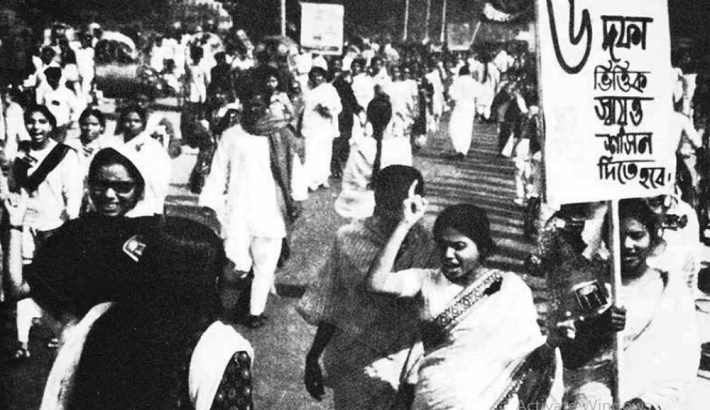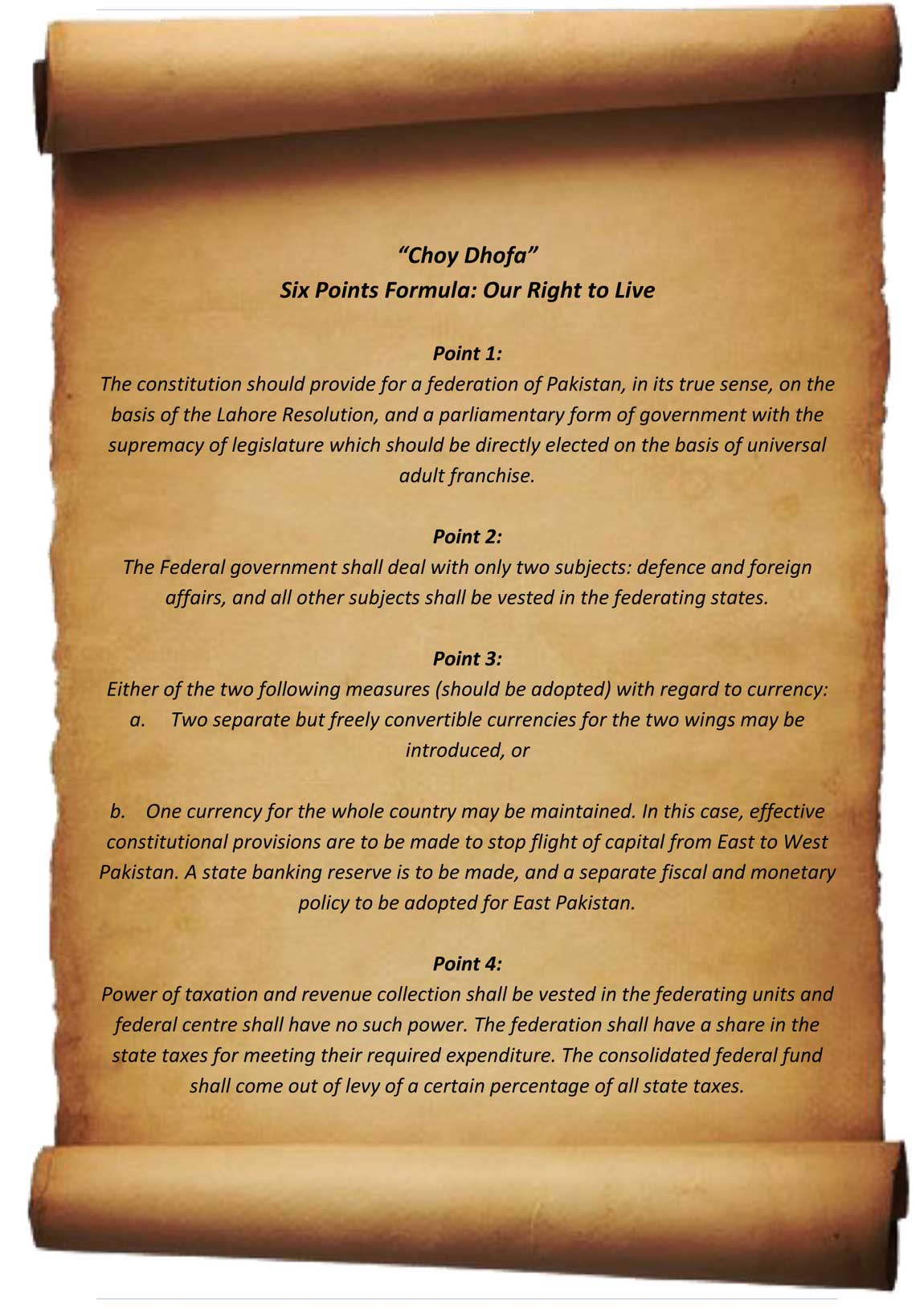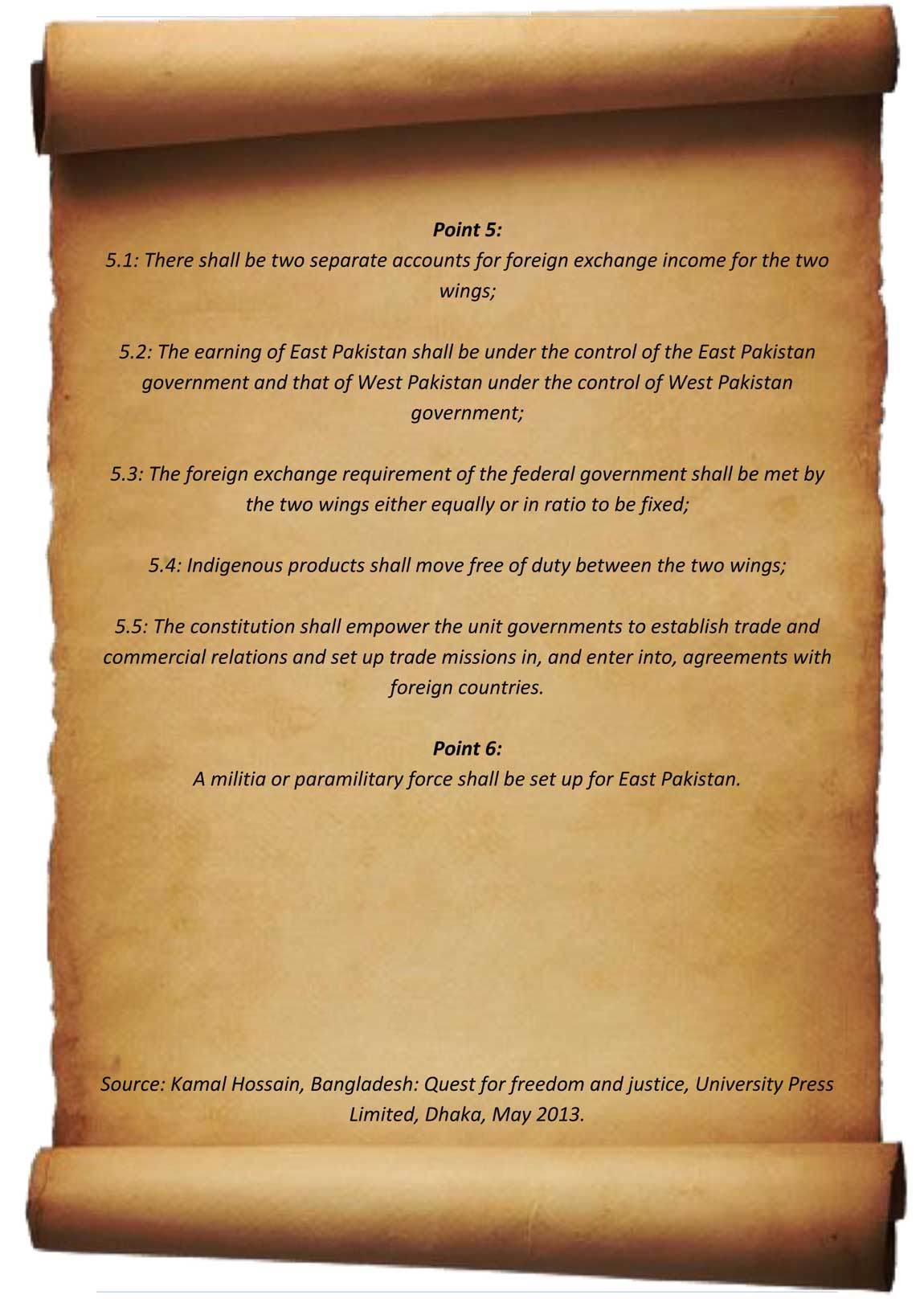
Besides other political parties, the 6-point formula of Sheikh Mujib was also rejected by National Awami Party
By Anwar A. Khan
The six-point demand marks a unique and an important change of course in the annals of history and thus is a milestone event in Bangladesh.
It was a movement in the-then East Pakistan, spearheaded by Bangabandhu Sheikh Mujibur Rahman, which called for greater autonomy for East Pakistan. The movement’s main agenda was to realize the six demands put forward by a coalition of Bengali nationalist political parties in 1966, to end the exploitation of East Pakistan by the West Pakistani rulers. It is considered a turning-point on the road to Bangladesh’s independence.
Following the partition of India, the new state of Pakistan came into being. The inhabitants of East Pakistan (later Bangladesh) made up the majority of its population, and exports from East Pakistan (such as, jute etc.) were a majority of Pakistan’s export income. However, East Pakistanis did not have a proportional share of political power and economic benefits within Pakistan.
East Pakistan was facing a critical situation after being subjected to continuous discrimination on a regional basis, year after year. As a result, the economists, intelligentsia, and the politicians of East Pakistan started to raise questions about this discrimination, giving rise to the historic six-point movement.

The historical six points are noted as being:
- The Constitution should provide for a Federation of Pakistan in its true sense based on the Lahore Resolution, and the parliamentary form of government with supremacy of a Legislature directly elected on the basis of universal adult franchise.
- The federal government should deal with only two subjects: Defence and Foreign Affairs, and all other residual subjects should be vested in the federating states.
- Two separate, but freely convertible currencies for two wings should be introduced; or if this is not feasible, there should be one currency for the whole country, but effective constitutional provisions should be introduced to stop the flight of capital from East Pakistan to West Pakistan. Furthermore, a separate Banking Reserve should be established and separate fiscal and monetary policy be adopted for East Pakistan.
- The power of taxation and revenue collection should be vested in the federating units and the federal center would have no such power. The federation would be entitled to a share in the state taxes to meet its expenditures.
- There should be two separate accounts for the foreign exchange earnings of the two wings; the foreign exchange requirements of the federal government should be met by the two wings equally or in a ratio to be fixed; indigenous products should move free of duty between the two wings, and the constitution should empower the units to establish trade links with foreign countries.
- East Pakistan should have a separate military or paramilitary force, and Navy headquarters should be in East Pakistan.
 The proposal was rejected by politicians from West Pakistan and non-Awami League politicians from East Pakistan. It was rejected by the President of All Pakistan Awami League Nawabzada Nasarullah Khan. It was also rejected by National Awami Party, Jamaat-e-Islami, and Nezam-e-Islam. But the movement had the strong support from the population of the-then East Pakistan.
The proposal was rejected by politicians from West Pakistan and non-Awami League politicians from East Pakistan. It was rejected by the President of All Pakistan Awami League Nawabzada Nasarullah Khan. It was also rejected by National Awami Party, Jamaat-e-Islami, and Nezam-e-Islam. But the movement had the strong support from the population of the-then East Pakistan.
Mujib, who would not become Bangabandhu till three years later, had been placed in detention under the Defence of Pakistan Rules on 8 May 1966. The reason was not hard to understand: Field Marshal Mohammad Ayub Khan, President of Pakistan, made clear his opinion on the Six Points. He told the country that the purveyors of the Six Points would be dealt with in the language of weapons.
Ayub Khan was not the only individual who spotted a threat to Pakistan’s unity should the Six Points be acknowledged. His soon-to-be-out foreign minister Zulfikar Ali Bhutto challenged Mujib early in the year to a public debate at Dhaka’s Paltan Maidan on the Six Points. It was Tajuddin Ahmed, Bangladesh’s first Prime Minister who accepted the challenge on Mujib’s behalf. In the event, Bhutto did not turn up.
The leaders of the opposition parties of West Pakistan convened a national convention at Lahore on 6 February 1966 with a view to ascertaining the post-Tashkent political trend. Bangabandhu reached Lahore on 4 February along with the top leaders of Awami League, and the day following, he placed the Six-point charter of demand before the subject committee as the demands of the people of East Pakistan. He created pressure to include his proposal in the agenda of the conference. The subject committee rejected the proposal of Bangabandhu.
On the day following, the newspapers of West Pakistan published reports on the Six-point Program, and Sheikh Mujibur Rahman was projected as a separatist. Consequently, Sheikh Mujib abandoned the conference. The Six-point Program along with a proposal of movement for the realization of the demands was placed before the meeting of the working committee of Awami League on 21 February 1966, and the proposal was carried out unanimously.
Why the Six-Point Program is called as – “The charter of freedom to the Bengali Nation”? From 1947 to 1971, a historic period for East Pakistan was a time that witnessed many painful events taking place in this region.
The points were clear, easy to understand and most importantly were true resemblance of the feelings of the Bengalis. It was for the first time when Bengalis shouted, asking for their economic and political rights and national security. But the response from the West Pakistan was rather painful and humiliating. It was an event that confirmed the reality that East Pakistan was a colony to the West Pakistan.
The 7 June 1966 is a red-letter day in the history of freedom movements of the people of Bangladesh. It was on this historic day that struggling people of this country took a firm and solemn vow for the achievement of their self-determination under the able and dynamic leadership of Bangabandhu Sheikh Mujibur Rahman.
Hence, the day has great political significance. It was, once again on this day, that blood flowed out of the veins of our people as they demanded their self-rule through the famous Charter of Six-point Demands of Bangabandhu which ultimately became the Magna Carta of all movements that emanated from the soil of Bangladesh. So, the importance and significance of this historic day can hardly be over-emphasized.
If we trace the history of our freedom struggle which started long back, we will observe that Bangabandhu as a part of his long-term plan to take his people gradually and systematically to the ultimate path of emancipation gave his historic Six-point Program to the nation at a national conference of leaders of the then all political parties at Lahore on February 16, 1966. This program of Bangabandhu had upset by the Islamabad ruling clique all the scheme of exploitation planned and raised a violent storm in the political arena of the-then Pakistan.
The erstwhile Pakistan Government tried their best to suppress the demand for self-determination raised by seventy-five million people of that time, as was laid down in the Magna Carta of Bangabandhu. As a result of the Six-point Program, Bangabandhu was put behind bars on May 8, l966, along with his other followers. The arrest of Bangabandhu and his followers was vehemently resented by the people, and the whole of Bangladesh protested like one entity by holding meetings, rallies and processions which rocked the distant capital at Rawalpindi.
On May 20, the Awami League Working Committee decided to organize a protest meeting on June 7, 1966 by condemning repression and demanding release of Bangabandhu and other leaders, and thus came the observance of strike on 7 June. The day dawned with factories remaining closed, transport off the roads and business houses shut down. This was the way people tried to express their indignation against the oppressors and resolute support to the leadership of Bangabandhu.
People came out to the streets closing their establishments, offices and shops. They suspended all their normal activities. Dhaka became the city of processions and slogans. The workers and students brought out peaceful processions. But the regime of exploiters could not tolerate slogan-chanting people who had made a sacred vow to realize their right to self-determination and so the ruling clique responded with the language of weapons killing scores of people including Monu Mia in Dhaka and Narayanganj. Thus, the people of Bangladesh raised their slogans for independence by shedding blood.
The song did not end here; the melody lingered on…Every glory has a price to pay. The Bengalis had to pay a high price for their freedom. But the great Liberation War brought the nation together. It was the moment of truth for the Bengalis when they all united to join hands to fight the Pakistani aggressors. In the eyes of the Pakistani forces, they were no longer just little brown people; instead they fought back and got their victory.
At long last, Bangladesh took birth on 16 December in 1971 after a bloody war.
Such a big man was Bangabandhu, and he became the undisputed Father of independent Bangladesh. To be unaware of this is sheer ignorance. To deny this is an offence against history. And this is the pride and glory and the spirit of our glorious Liberation War with Pakistan.
_________________
The writer is an independent political analyst of Bangladesh who writes on politics, political and human-centered figures, current and international affairs.
Courtesy: Daily Sun, Dhaka